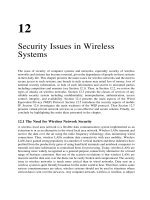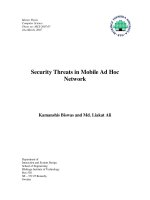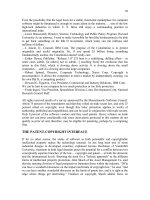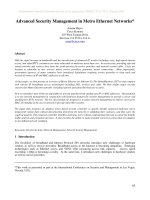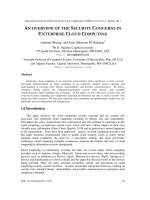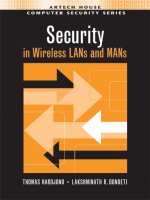Security Issues in Wireless Systems
Bạn đang xem bản rút gọn của tài liệu. Xem và tải ngay bản đầy đủ của tài liệu tại đây (218.21 KB, 14 trang )
12
Security Issues in Wireless
Systems
The issue of security of computer systems and networks, especially security of wireless
networks and systems has become essential, given the dependence of people on these systems
in their daily life. This chapter presents the main issues for wireless networks and the need to
secure access to such systems; any breach to such systems may entail loss of money, loss of
national security information, or leak of such information and secrets to unwanted parties
including competitors and enemies (see Section 12.1). Then, in Section 12.2, we review the
types of attacks on wireless networks. Section 12.3 presents the classes of services of any
reliable security system including confidentiality, nonrepudiation, authentication, access
control, integrity, and availability. Section 12.4 presents the main aspects of the Wired
Equivalent Privacy (WEP) Protocol. Section 12.5 introduces the security aspects of mobile
IP. Section 12.6 investigates the main weakness of the WEP protocol. Then Section 12.7
presents virtual private network services as a cost-effective and secure scheme. Finally, we
conclude by highlighting the main ideas presented in the chapter.
12.1 The Need for Wireless Network Security
A wireless local area network is a flexible data communication system implemented as an
extension to or as an alternative to the wired local area network. Wireless LANs transmit and
receive the data over the air using the radio frequency technology, thus minimizing wired
connections. Thus, wireless LANs combine data connectivity with user mobility. Wireless
LANs have gained strong popularity in a number of vertical markets and these industries have
profited from the productivity gains of using hand held terminals and notebook computers to
transmit real-time information to centralized hosts for processing. Today, wireless LANs are
becoming more widely recognized as a general-purpose connectivity alternative for a broad
range of business customers. But one of the scariest revelations is that wireless LANs are
insecure and the data sent over the them can be easily broken and compromised. The security
issue in wireless networks is much more critical than in wired networks. Data sent on a
wireless system is quite literally broadcast for the entire world to hear. Therefore, unless some
serious countermeasures are taken, wireless systems should not be used in situations where
critical data is sent over the airwaves. Any computer network, wireless or wireline, is subject
to substantial security risks. The major issues are [1–3]: (a) threats to the physical security of
the network; (b) unauthorized access by unwanted parties; and (c) privacy.
A certain level of security is a must in almost all local area networks, regardless of whether
they are wireless or wireline-based. There is no LAN owner who wants to risk having the
LAN data exposed to unauthorized users or malicious attackers. If the data carried in the
networks are sensitive, such as that found on the networks of financial institutions and banks,
and e-commerce, e-government, and military networks, then extra measures must be taken to
ensure confidentiality and privacy.
This chapter deals with various security issues related to wireless LANs including those
that have been implemented in the IEEE 802.11 standard.
12.2 Attacks on Wireless Networks
The dependence of people on computer networks including wireless networks has increased
tremendously in recent years and many corporations and businesses rely heavily on the
effective, proper and secure operation of these networks. The total number of computer
networks installed in most organizations has increased at a phenomenal rate. Corporations
store sensitive and confidential information on marketing, credit records, income tax, trade
secrets, national security data, and classified military data, among others. The access of such
data by unauthorized users may entail loss of money or release of confidential information to
competitors or enemies [2].
Attacks on computer systems and networks can be divided into passive and active attacks
[1–3]. Active attacks involve altering data or creating fraudulent streams. These types of
attacks can be divided into the following subclasses: (a) masquerade; (b) reply; (c) modifica-
tion of messages; and (d) denial of service. A masquerade occurs when one entity pretends to
be a different entity. For example, authentication can be collected and replayed after a valid
authentication sequence has taken place. Reply involves the passive capture of a data unit and
its subsequent retransmission to construct unwanted access. Modification of messages means
that some portion of a genuine message is changed or that messages are delayed or recorded
to produce an unauthorized result.
Passive attacks are inherently eavesdropping or snooping on transmission. The attacker
tries to access information that is being transmitted. There are two subclasses: release of
message contents, and traffic analysis. In the first type, the attacker reaches the e-mail
messages or a file being transferred. In traffic analysis type of attack, the attacker could
discover the location and identity of communicating hosts and could observe the frequency
and length of encrypted messages being exchanged. Such information could be useful to the
attacker as it can reveal useful information in guessing the nature of the information being
exchanged [2,3].
In general, passive attacks are difficult to detect, however, there are measures that can be
used to avoid them. On the other hand, it is difficult to prevent active attacks.
The main categories of attack on wireless computer networks are [2,5,6]:
†
Interruption of service. Here, the resources of the system are destroyed or become unavail-
able.
†
Modification. This is an attack on the integrity of the system. In this case, the attacker not
Wireless Networks328
only gains access to the network, but tampers with data such as changing the values in a
database, altering a program so that it does different tasks.
†
Fabrication. This is an attack on the authenticity of the network. Here the attacker inserts
counterfeit objects such as inserting a record in a file.
†
Interception. This is an attack on the confidentiality of the network such as wiretapping or
eavesdropping to capture data in a network. Eavesdropping is easy in a wireless network
environment since when one sends a message over a radio path, everyone equipped with
the proper transceiver equipment in the range of transmission can eavesdrop the data.
These kinds of devices are usually inexpensive. The sender or intended receiver may not
be able to find out whether their messages have been eavesdropped or not. Moreover, if
there is no special electromagnetic shielding, the traffic of a wireless network can be
eavesdropped from outside the building where the network is operating. In most wireless
networks, there is a kind of link level ciphering done by the MAC entities.
†
Jamming. Interruption of service attacks is also easily applied to wireless networks. In
such a case, the legitimate traffic cannot reach clients or access points due to the fact that
illegitimate traffic overwhelms the frequencies. An attacker can use special equipment to
flood the 2.4 GHz frequency band. Such a denial of service can originate from outside the
service area of the access point, or from other wireless devices installed in other work
areas that degrade the overall strength of the signal.
†
Client-to-client attacks. Wireless network users need to defend clients not just against an
external threat, but also against each other. Wireless clients that run TCP/IP protocols such
as file sharing are vulnerable to the same misconfigurations as wired networks. Also,
duplication of IP or MAC addresses whether its intentional or accidental, may cause
disruption of service.
†
Attacks against encryption. The IEEE 802.11b standard uses an encryption scheme called
Wired Equivalent Privacy (WEP) which has proven to have some weaknesses. Sophisti-
cated attacker can break the WEP scheme.
†
Misconfiguration. In order to have ease and rapid deployment, the majority of access
points have an unsecured configuration. This means that unless the network administrator
configures each access point properly, these access points remain at high risk of being
accessed by unauthorized parties or hackers.
†
Brute force attacks against passwords of access points. The majority of access points use a
single password or key, which is shared by all connecting wireless clients. Attackers can
attempt to compromise this password or key by trying all possibilities. Once the attacker
guesses the key or the password, he/she can gain access to the access point and compro-
mise the security of the system. Moreover, not changing the passwords or keys on a regular
basis may put the network system at great risk especially if employees leave the company.
On the other hand, managing a large number of access points and clients complicates the
security system.
†
Insertion attacks. This type of attack is based on deploying a new wireless network
without following security procedure. Also, it may be due to installation of an unauthor-
ized device without proper security review. For example, a company may not know that
some of its employees have deployed wireless facilities on its network. Using such a rogue
access point, the database of the company will be compromised. Clearly, there is a need to
implement a policy to secure the configuration of all access points, in addition to a routine
process by which the network is scanned for unauthorized devices in its wireless portion.
Security Issues in Wireless Systems 329
Another example is that an attacker may connect a laptop or a PDA to an access point
without the authorization of the owner of the wireless network. If the attacker was able to
gain access by getting a password or if there is no password or key requirement, then the
attacker/intruder will be able to connect to the internal network.
Any network security system should maintain the following characteristics [2–4,6–12]:
†
Integrity. This requirement means that operations such as substitution, insertion or dele-
tion of data can only be performed by authorized users using authorized methods. Three
aspects of integrity are commonly recognized: authorized actions, protection of resources,
and error detection and correction.
†
Confidentiality. This means that the network system can only be accessed by authorized
users. The type of access can be read-only access. Another is privileged access where
viewing, printing, or even knowing the existence of an object is permitted.
†
Denial of service. This term is also known by its opposite, availability. An authorized
individual should not be prevented or denied access to objects to which he has legitimate
access. This access applies to both service and data. Denning [6] states that the effective-
ness of access control is based on two ideas: (a) user identification and (b) protecting the
access right of users.
Computer networks, in general, have security problems due to:
†
Sharing. Since network resources are shared, more users have the potential to access
networked systems rather than just a single computer node.
†
Complexity. Due to the complexity of computer networks of all types, reliable and secure
operation is a challenge. Moreover, computer networks may have dissimilar nodes with
different operating systems, which makes security more challenging.
†
Anonymity. A hacker or intruder can attack a network system from hundreds of miles away
and thus never have to touch the network or even come into contact with any of its users or
administrators.
†
Multiple point of attack. When a file exists physically on a remote host, it may pass many
nodes in the network before reaching the user.
†
Unknown path. In computer networks, routes taken to route a packet are seldom known
ahead of time by the network user. Also these users have no control of the routes taken by
their own packets. Routes taken depend on many factors such as traffic patterns, load
condition, and cost.
12.3 Security Services
Security services can be classified as follows [2,7–12]:
†
Confidentiality. This service means the protection of data being carried by the network
from passive attacks. The broadcast service should protect data sent by users. Other forms
of this service include the protection of a single message or a specific field of a message.
Another aspect of confidentiality is the protection of traffic from a hacker who attempts to
analyze it. In other words, there must be some measures that deny the hackers from
observing the frequency and length of use, as well as other traffic characteristics in the
network.
Wireless Networks330
†
Nonrepudiation. This service prevents the sending or receiving party from denying the
sent or received message. This means that when a message is received, the sender can
confirm that the message was in fact received by the assumed receiver.
†
Authentication. The authentication service is to ensure that the message is from an authen-
tic source. In other words, it ensures that each communicating party is the entity that it
claims to be. Also, this service must ensure that the connection is not interfered with in a
way that a third party impersonates one of the authorized parties.
†
Access control. This service must be accurate and intelligent enough so that only author-
ized parties can use the system. Also, this accuracy should not deny authorized parties
from using the network system.
†
Integrity. In this context, we differentiate between connection-oriented and connection-
based integrity services. The connection-oriented integrity service deals with a stream of
messages, and ensures that the messages are sent properly without duplication, modifica-
tion, reordering or reply. Moreover, the denial of service aspect is covered under the
connection-oriented service. The connectionless integrity service deals only with the
protection against message modification. A hybrid type of integrity service was proposed
to deal with the applications that require protection against replay and reordering, but do
need strict sequencing [2–4]. A good security system should be able to detect any integrity
problem and if a violation of integrity is reported, then the service should report this
problem. A software mechanism or human intervention should resolve this problem.
The software approach is supposed to resolve the problem automatically without human
intervention.
†
Availability. Some attacks may result in loss or reduction of availability of the system.
Automated schemes can resolve some of these problems while others require some type of
physical procedures.
12.4 Wired Equivalent Privacy (WEP) Protocol
The name, wired equivalent privacy (WEP), implies that the goal of WEP is to provide the
level of privacy that is equivalent to that of a wired LAN. This was designed to provide
confidentiality for network traffic using wireless protocols. WEP was intended to provide a
similar level of privacy over wireless networks that one may get from a wired network. The
WEP algorithm is used to protect wireless networks from eavesdropping. It is also meant to
prevent unauthorized access to wireless networks. The scheme relies on a secret key that is
shared between a wireless node and an access point. The secret key is used to encrypt data
packets before sending them. The IEEE 802.11 standard does not specify how the standard
key is established and most implementations use a single key that is shared between all
mobiles and access points.
WEP relies on a default set of keys, which are shared between wireless LAN adapters and
access points [13].
The IEEE 802.11 committee has established standards for wireless LANs and several
companies have designed wireless LAN products that are compatible with these universal
standards. Wireless networks users are primarily concerned that an intruder should not be
able to: (a) access the network by using similar wireless LAN equipment; and (b) capture
wireless LAN traffic by eavesdropping or other methods for further analysis [14].
Security Issues in Wireless Systems 331
